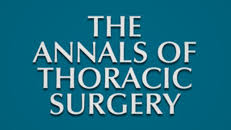Titus JM, Mason DP, Raymond DP, Rice TW, Murthy SC
Ann Thorac Surg. 2013 Aug;96(2):689-91.
Endoscopic treatment of gastroesophageal reflux disease (GERD) is emerging as an alternative to open, laparoscopic, or robotic antireflux surgical procedures. Early transoral devices failed because of poor efficacy and serious adverse events. In recent trials the EsophyX device has demonstrated acceptable safety and a reasonable efficacy profile. We present the case of a woman who experienced a distal esophageal perforation and esophagopulmonary fistula after treatment for GERD with the EsophyX device. Although considered minimally invasive, endoscopic procedures for GERD treatment can have significant deleterious consequences, and early recognition of these complications is vital to limit associated morbidity.
Link to abstract on PubMed: Titus JM, et al; Ann Thorac Surg. 2013 Aug;96(2):689-91.
For PDF download of open access paper, click through the Full Text link in the upper right corner of the PubMed abstract page.


